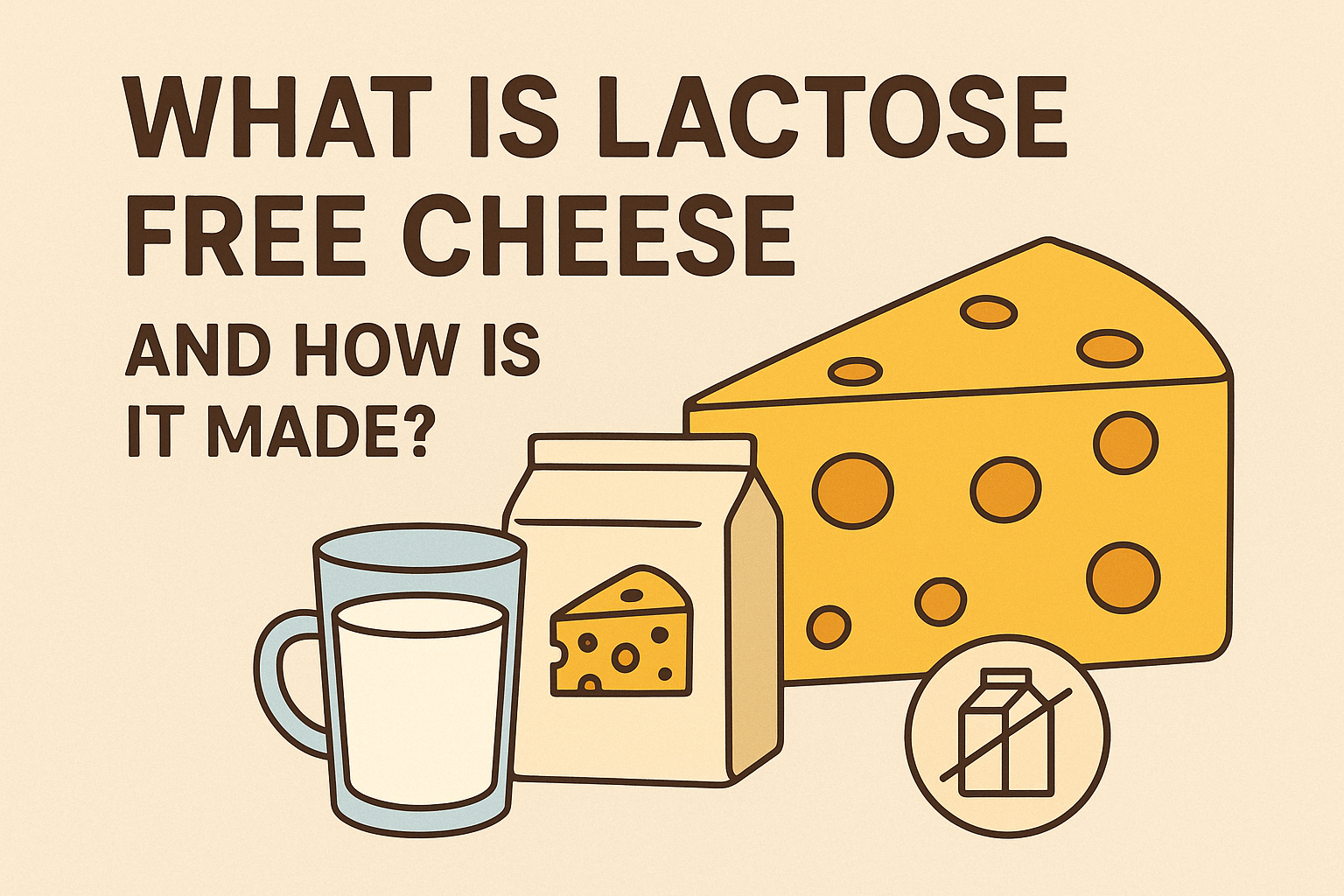Introduction to Lactose Free Cheese
Lactose free cheese has become a staple for many, offering a delicious alternative for those who are sensitive to lactose. If you’re part of the growing number of people avoiding this natural sugar found in milk products, you’re not alone. Whether it’s due to lactose intolerance or simply a preference for dairy-free options, there’s no need to miss out on your favorite cheesy delights.
Imagine biting into a creamy slice of cheddar or melting mozzarella over your pizza without any discomfort. Lactose free cheese not only makes this possible but also opens up endless culinary possibilities! Let’s dive into the world of lactose free cheese and discover what it is, how it’s made, and why it just might be the perfect addition to your diet.
What is Lactose and Why Do Some People Need to Avoid It?
Lactose is a natural sugar found in milk and dairy products. It’s composed of two simpler sugars, glucose and galactose. For most people, the body easily breaks down lactose with an enzyme called lactase.
However, some individuals lack sufficient lactase production. This condition is known as lactose intolerance. When lactose isn’t properly digested, it can lead to uncomfortable symptoms like bloating, gas, diarrhea, and abdominal pain.
The prevalence of lactose intolerance varies by ethnicity and age. Many adults around the world experience this issue as they age or due to genetic factors. For those affected, consuming regular dairy products can be quite distressing.
Avoiding lactose becomes essential for maintaining comfort and health in these cases. Luckily, alternatives like lactose free cheese offer delicious options without the unpleasant side effects associated with traditional dairy.
The Process of Making Lactose Free Cheese
The process of making lactose free cheese begins with the selection of high-quality milk. This can be cow’s, goat’s, or sheep’s milk. The key difference lies in the treatment of this milk to remove or break down lactose.
Next, lactase enzyme is added to the milk. Lactase works by breaking lactose into simpler sugars—glucose and galactose—which are easier for many people to digest.
Once the enzyme has had time to work its magic, traditional cheese-making techniques take over. Rennet is introduced to curdle the milk, creating solid curds and liquid whey.
After that, these curds are drained and pressed to form cheese blocks or wheels. Depending on the type desired—soft or hard—the aging process varies from a few weeks to several months.
Throughout this journey from liquid to solid gold, care is taken at each step, ensuring a delicious end product without any pesky lactose lingering around.
Types of Lactose Free Cheese Available
Lactose free cheese comes in a variety of types, offering something for everyone. Popular options include mozzarella, cheddar, and cream cheese. Each type maintains its distinctive flavor while eliminating lactose.
Mozzarella is fantastic for pizza lovers. It melts beautifully and pairs well with fresh basil and tomatoes.
Cheddar offers a sharp taste that’s perfect for sandwiches or burgers. Many brands produce several aging profiles, from mild to extra sharp.
Cream cheese brings a smooth texture to bagels and desserts without the discomfort of lactose. It’s also great for creamy dips.
For those who enjoy gourmet flavors, there are lactose free blue cheeses available too! They deliver that tangy kick beloved by many while being gentle on the digestive system.
Each product caters to various culinary uses ensuring you can still indulge in your favorite dishes without worry.
Health Benefits of Lactose Free Cheese
Lactose free cheese offers a delicious alternative for those sensitive to lactose. One of its primary benefits is improved digestion. Without the lactose sugar, individuals can enjoy cheese without discomfort.
It’s also a great source of essential nutrients. Many varieties retain high levels of calcium and protein, contributing to bone health and muscle maintenance.
For people watching their weight, lactose free options often come with fewer calories compared to regular cheeses. They can easily fit into healthier meal plans.
Additionally, lactose free cheese is commonly fortified with vitamins such as B12 and D. This makes it an excellent choice for vegans who miss out on dairy nutrients.
Enjoying this type of cheese means indulging in flavors without compromising dietary needs or preferences. It opens up culinary possibilities while keeping meals satisfying and nutritious.
How to Use Lactose Free Cheese in Cooking and Baking
Lactose free cheese is incredibly versatile and can be used in a variety of dishes. Whether you’re making a creamy pasta or a hearty lasagna, it melts beautifully, adding richness without the discomfort.
For simple snacks, try topping your favorite crackers with lactose free cheese. Pairing it with fruits like apples or pears creates a delightful contrast that’s both satisfying and delicious.
In baking, this cheese works wonders in recipes for quiches or savory muffins. Its mild flavor complements spices and herbs perfectly.
If you love pizza night, use lactose free mozzarella to create gooey toppings on your crusts. You won’t miss out on classic flavors while staying comfortable.
Experimenting with different types can elevate salads too! Crumbled lactose free feta adds tanginess to greens, enhancing every bite without the worry of digestive issues.
Comparison with Regular Cheese
Lactose free cheese and regular cheese share many similarities, yet they cater to different dietary needs. Both can offer rich flavors and diverse textures, making them essential ingredients in various dishes.
One of the key differences lies in their lactose content. Regular cheese contains lactose, a sugar that can cause digestive issues for those with intolerance. In contrast, lactose free cheese undergoes a process that breaks down this sugar, ensuring it remains gentle on sensitive stomachs.
Nutritionally, both types provide protein and calcium. However, some brands of lactose free cheese may have added enzymes or lactase to aid digestion further.
Taste-wise, many people find little difference between the two varieties. Chefs often use lactose free options seamlessly in recipes without compromising flavor or texture. This versatility makes it an excellent choice for cooking enthusiasts who want inclusivity at the table.
Where to Find and Purchase Lactose Free Cheese
Finding lactose free cheese has become easier in recent years. Many grocery stores now stock a variety of options in their dairy aisles. Look for dedicated sections labeled specifically for lactose-free products.
Local health food stores often carry artisanal brands that focus on specialty items, including gourmet lactose free cheeses. These shops usually have knowledgeable staff who can help you select the best product for your needs.
Don’t overlook online retailers either. Websites specializing in natural foods frequently offer an extensive selection of lactose free cheese, often with delivery straight to your door. This is particularly useful if local options are limited.
Farmers’ markets might feature local producers who make fresh lactose free varieties as well. Interacting with vendors provides a chance to ask questions and sample products before buying.
Be sure to check labels carefully when shopping, making sure they clearly indicate “lactose-free.”
Tips for Incorpor
When incorporating lactose free cheese into your diet, consider the following tips to make the most of this versatile ingredient. First, start with a small amount if you’re new to it. This allows you to gauge how your body reacts without any discomfort.
Experiment with different melting properties by choosing varieties like mozzarella or cheddar for dishes that require gooey textures. If you’re using lactose free cheese for baking, remember that it may behave differently than regular cheese due to its altered composition.
Pair lactose free cheeses with complementary flavors. For instance, a sharp aged variety can bring out sweetness in fruits or balance spicy elements in savory dishes. Don’t be afraid to incorporate them into classic recipes; they can elevate mac and cheese or enhance pizza night.
Keep an eye on labels when shopping. Some brands offer naturally lactose-free options while others are processed specifically for those who need dairy alternatives. Finding what works best will allow you to enjoy all the deliciousness of cheese without compromising your health needs.
By following these simple tips, you can easily add lactose free cheese into various meals and enjoy its rich flavor without worry.

















